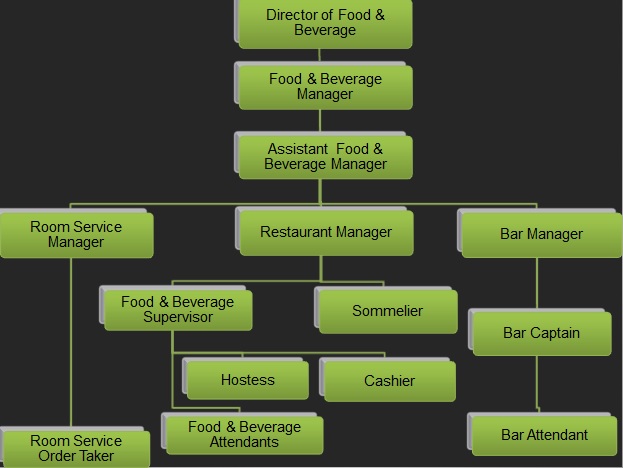Have you ever wondered about the intricate network of roles and responsibilities that bring the magic of a restaurant, hotel, or catering event to life? Imagine a bustling kitchen, a perfectly set table, and a symphony of aromas – all orchestrated with precision and finesse. At the heart of this culinary ballet lies the organizational chart of the Food and Beverage (F&B) department, a roadmap that outlines the hierarchy and functional areas that ensure smooth operations and customer delight.

Image: www.bharatagritech.com
Understanding the F&B organizational chart is crucial for anyone working within the hospitality industry or simply trying to make sense of the behind-the-scenes operations of their favorite dining destinations. This chart acts as a blueprint, guiding communication, decision-making, and accountability within the department, enabling the team to work in harmony to achieve culinary excellence.
The Backbone of Culinary Operations: Key Roles and Responsibilities
At the helm of the F&B department stands the Food & Beverage Director (F&BD), the maestro of the culinary symphony. This individual oversees all aspects of the department, ensuring seamless operations, financial stability, and consistent customer satisfaction. The F&BD might have several direct reports, including:
- Executive Chef: The culinary mastermind, responsible for creating and managing the menu, overseeing the kitchen team, and ensuring food quality and consistency.
- Restaurant Manager: The leader of the front-of-house operations, responsible for guest service, reservations, table management, and staff training.
- Banquet Manager: A specialist in handling large-scale events, managing catering services, and ensuring flawless execution of banquets and conferences.
A Deeper Dive into Functional Areas:
The F&B organizational chart encompasses a multitude of roles, each playing a critical part in delivering a memorable dining experience.
-
Kitchen Operations: Under the Executive Chef’s leadership, the kitchen team is divided into distinct areas, each with dedicated roles:
- Sous Chef: The second-in-command, assisting the Executive Chef, managing kitchen staff, and ensuring consistency in recipes and plating.
- Pastry Chef: The master of desserts, responsible for creating delectable pastries, cakes, and other sweet treats.
- Line Cook: Highly skilled cooks specializing in particular sections, like sauté, grill, or garde manger (cold food).
- Prep Cook: Responsible for preparing ingredients and mise en place (prepping) for the line cooks.
- Dishwashers: A vital support role, ensuring the cleanliness of kitchen equipment and dishware.
-
Service Operations: The Restaurant Manager oversees the front-of-house team, ensuring smooth service and guest satisfaction:
- Head Waiter: Leads the service team, ensuring efficient communication, table management, and guest satisfaction.
- Servers: The frontline of guest service, responsible for taking orders, serving food and beverages, and attending to guest needs.
- Bartenders: Mixologists extraordinaire, crafting cocktails and serving alcoholic beverages.
- Busboys: Assist servers by clearing tables, refilling water, and providing general support.
-
Banquet and Catering: The Banquet Manager leads the team that handles large-scale events, ensuring seamless execution and guest satisfaction:
- Banquet Servers: Experienced servers trained to handle larger events and provide attentive service.
- Banquet Captains: Supervise banquet servers, ensure smooth service flow, and manage the overall banquet operation.
- Catering Coordinator: Manages the catering aspect, coordinating menus, setting up events, and ensuring on-time delivery of food and beverages.
-
Beverage Operations: In larger organizations, a separate Beverage Manager may oversee all aspects of beverage distribution and service:
- Wine Steward: A specialist in wine knowledge, responsible for selecting and managing the wine list.
- Beverage Server: Focuses on serving alcoholic and non-alcoholic beverages.
Unlocking Insights: Demystifying the Structure
The specific structure of an F&B organizational chart varies depending on the size and type of establishment, but the underlying principles remain the same.
- Clarity and Communication: The chart provides a clear overview of roles and responsibilities, facilitating seamless communication and decision-making within the department.
- Accountability: Each position has defined roles and responsibilities, making individuals accountable for their actions and performance.
- Efficiency: The hierarchical structure ensures a streamlined workflow, minimizing confusion and optimizing operational efficiency.

Image: www.foodandbeveragetrainer.com
Expert Insights and Actionable Tips:
Here are some valuable tips from industry experts on navigating the F&B organizational chart:
- Embrace Collaboration: The success of any F&B department relies on collaboration between departments.
- Build Strong Relationships: Cultivating strong relationships with your colleagues, regardless of their role, is essential for a positive and productive work environment.
- Communication is Key: Clear and effective communication is vital for smooth operations and optimal customer satisfaction.
Organizational Chart Food And Beverage Department
Looking Ahead: The Future of Food and Beverage
The F&B industry is constantly evolving, fueled by new technologies, changing dining trends, and a growing emphasis on sustainability. As we move forward, we can expect to see the organizational chart adapt and evolve to meet these emerging challenges and opportunities.
Call to Action: Understanding the organizational chart of an F&B department is an important step towards appreciating the artistry and complexity of this fascinating industry. Whether you’re a seasoned professional or a casual diner, gaining insights into this structure can enhance your appreciation for the culinary journey from the kitchen to the customer’s table.






